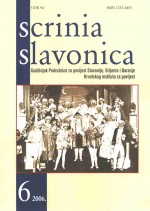Demokratske promjene, uvođenje višestranačja i izbori na području Brodsko-posavske županije od 1990. do 1993. (Drugi dio)
Democratic changes, political pluralism, and elections in the Brod-Posavina County between 1990 and 1993 (Part Two)
Author(s): Mario Kevo, Ivan JelićSubject(s): History
Published by: Hrvatski institut za povijest
Keywords: Republic of Croatia; Brod – Posavina County; Slavonski Brod; Nova Gradiška; democratic changes; political pluralism; political parties; presidential; parliamentary and local (municipal; town and county) elections.
Summary/Abstract: This paper discusses the elections held in 1992 in what is today the Brod- Posavina County (presidential elections and parliamentary elections for the Chamber of Deputies of the Croatian Parliament), and those held in 1993 (for the Chamber of Counties of the Croatian Parliament and the local elections – county, city and municipal elections). All these elections, the parliamentary and presidential elections, the local elections at municipal, city and county level as well as the elections for the Chamber of Counties of the Parliament of the Republic of Croatia had a feature in common. They were all marked by a relatively short election campaign, which lasted around fifteen days, and a relatively good turnout despite the fact that they (especially the parliamentary and the presidential elections) were held under constant air raid warnings and general raid warnings. In addition, the elections were not held in the entire county, as a part of its territory was not under Croatian jurisdiction. As in the first multiparty elections, the 1992/1993 elections also brought landslide victories to the Croatian Democratic Union (HDZ), i.e. both the presidential candidate and the three candidates elected to the Chamber of Deputies in the election units covered by the municipalities of Nova Gradiška and Slavonski Brod were members of the HDZ. Standing out among the other ‘winners’ in these elections is first and foremost the Croatian Social Liberal Party (HSLS), which thus reinforced its position as the second leading political party in the Brod-Posavina County, and the Croatian Peasant Party (HSS) which achieved remarkably good results in the elections for the municipal counties. Testifying to the upswing of HSS is their absolute victory in several municipalities, which enabled them to independently form units of power in the area concerned. Further, according to the number of municipal council seats, HSS became the second most powerful party after HDZ in five municipalities (Donji Andrijevci, Garčin, Klakar, Oriovac and Podcrkavlje), or it was the only party which won any council seats besides the HDZ. HSS’s success becomes all the more important if one acknowledges the fact that the party was only active in the east part of the former municipality of Slavonski Brod. The Union of the Christian Democratic Party (HKDU) an the Croatian People’s Party (HNS) marked poor results, as did the Social Democratic Party (SDP). Namely, SDP only won three seats in the entire county (two seats on the City Council of Slavonski Brod and a single seat in the County Assembly) out of a total of 427 members elected for the county assembly, city and municipal councils. However, with the support of the Croatian Social Liberal Party (HSLS), dr. Zdravko Tomac (SDP) was elected into the Chamber of Deputies of the Parliament, and the results were slightly improved in comparison to the results achieved in the parliamentary elections...
Journal: Scrinia Slavonica
- Issue Year: 2006
- Issue No: 6
- Page Range: 539-594
- Page Count: 56
- Language: Croatian

